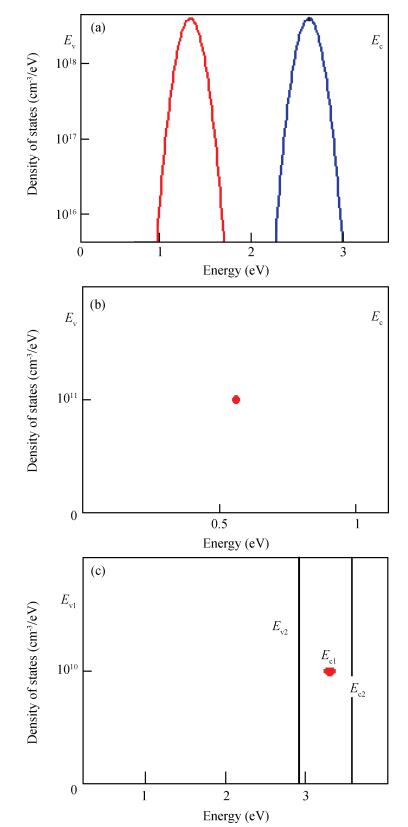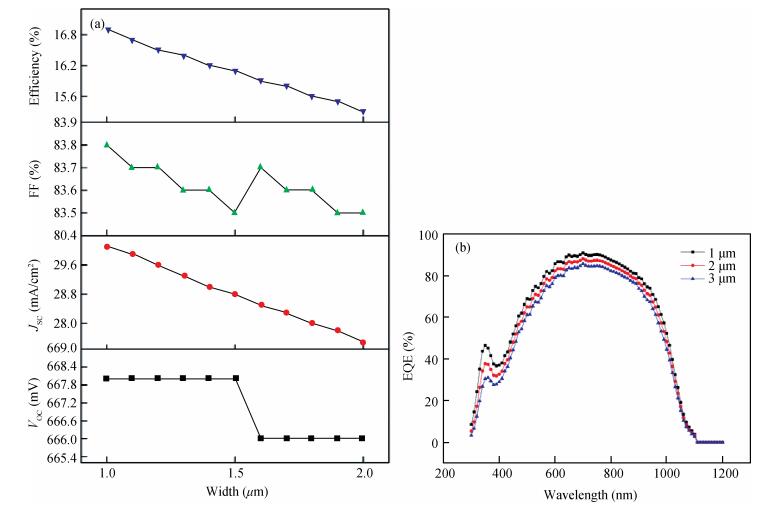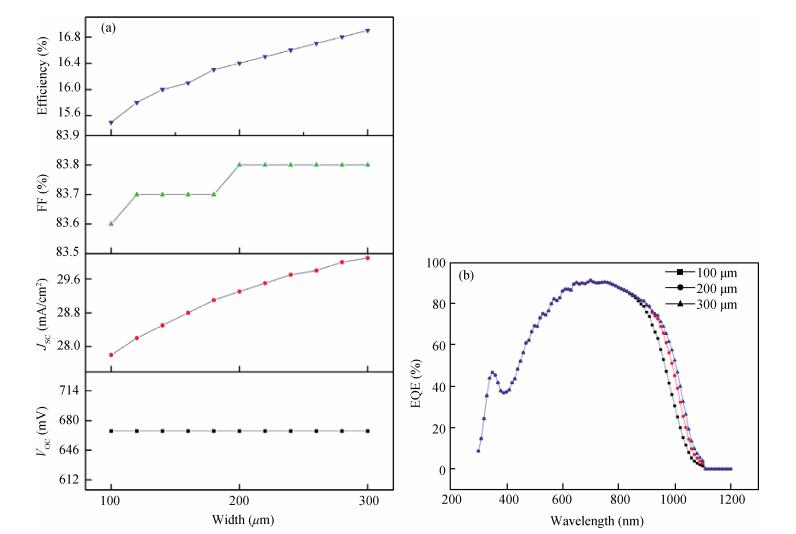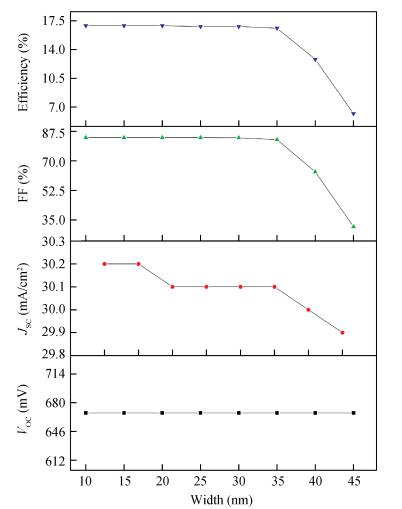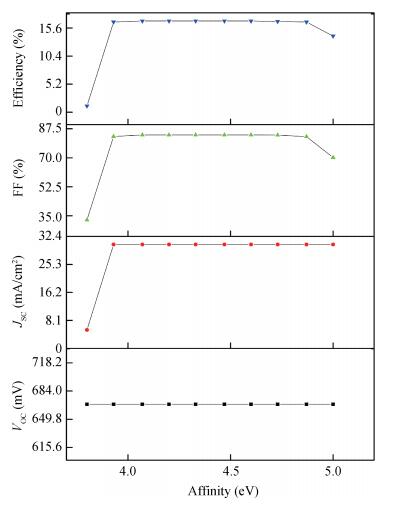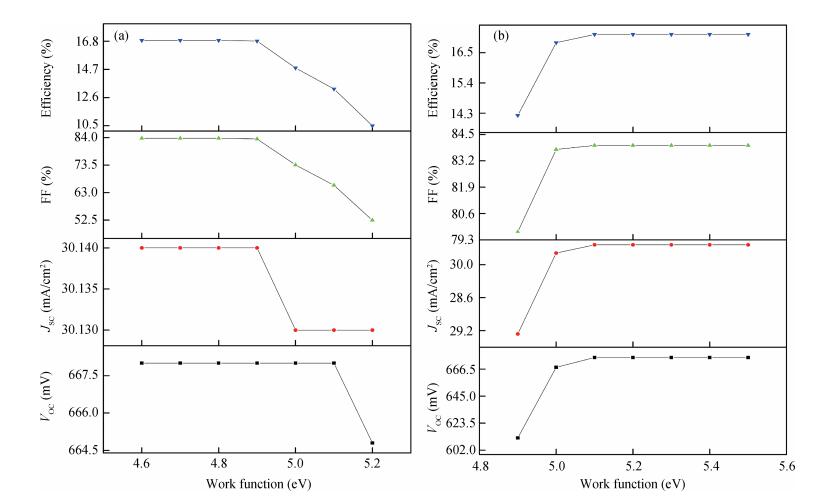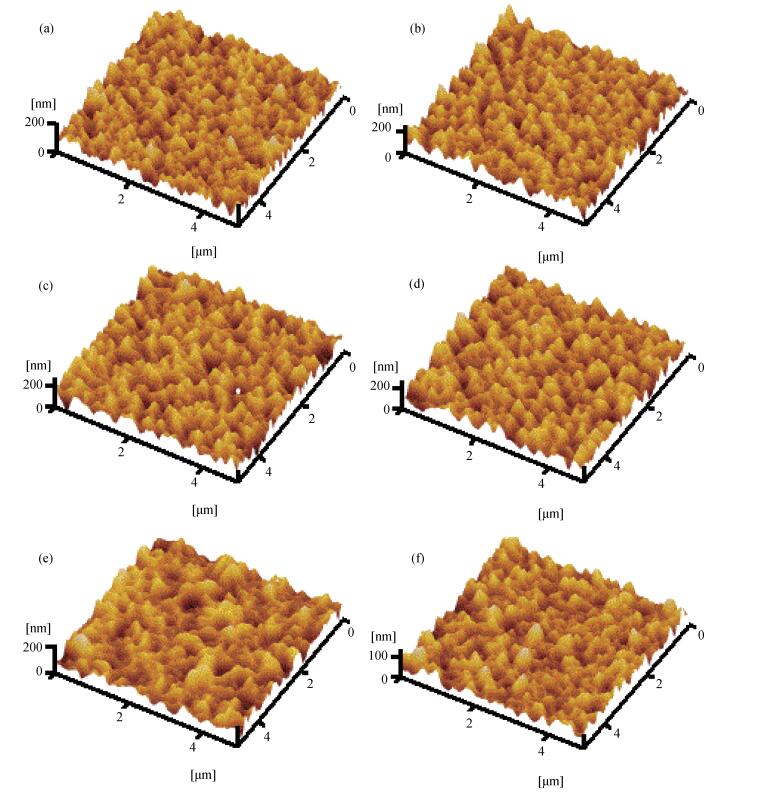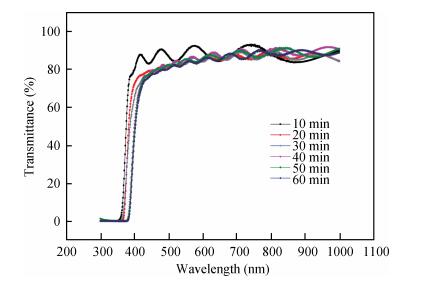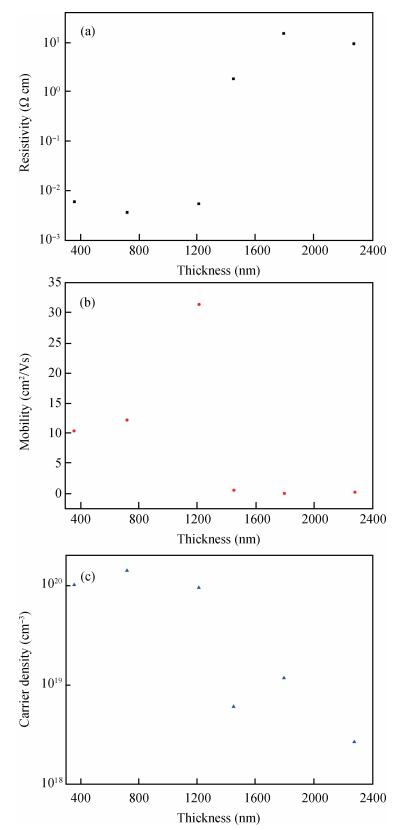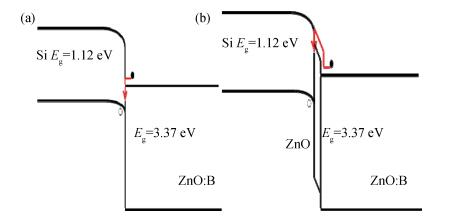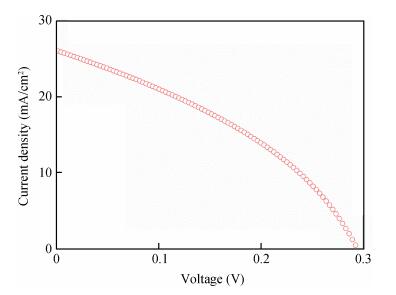| Citation: |
Li Chen, Xinliang Chen, Yiming Liu, Ying Zhao, Xiaodan Zhang. Research on ZnO/Si heterojunction solar cells[J]. Journal of Semiconductors, 2017, 38(5): 054005. doi: 10.1088/1674-4926/38/5/054005
****
L Chen, X L Chen, Y M Liu, Y Zhao, X D Zhang. Research on ZnO/Si heterojunction solar cells[J]. J. Semicond., 2017, 38(5): 054005. doi: 10.1088/1674-4926/38/5/054005.
|
-
Abstract
We put forward an n-ZnO/p-Si heterojunction solar cell model based on AFORS-HET simulations and provide experimental support in this article. ZnO:B (B-doped ZnO) thin films deposited by metal-organic chemical vapor deposition (MOCVD) are planned to act as electrical emitter layer on p-type c-Si substrate for photovoltaic applications. We investigate the effects of thickness, buffer layer, ZnO:B affinity and work function of electrodes on performances of solar cells through computer simulations using AFORS-HET software package. The energy conversion efficiency of the ZnO:B (n)/ZnO/c-Si (p) solar cell can achieve 17.16% (Voc: 675.8 mV, Jsc:30.24 mA/cm2, FF: 83.96%) via simulation. On a basis of optimized conditions in simulation, we carry out some experiments, which testify that the ZnO buffer layer of 20 nm contributes to improving performances of solar cells. The influences of growth temperature, thickness and diborane (B2H6) flow rates are also discussed. We achieve an appropriate condition for the fabrication of the solar cells using the MOCVD technique. The obtained conversion efficiency reaches 2.82% (Voc: 294.4 mV, Jsc: 26.108 mA/cm2, FF: 36.66%). -
References
[1] Chaabouni F, Abaab M, Rezig B. Characterization of n-ZnO/p-Si films grown by magnetron sputtering. Superlattices Microstruct, 2006, 39: 171 doi: 10.1016/j.spmi.2005.08.070[2] Hussain B, Ebong A, Ferguson I. Zinc oxide as an active n-layer and antireflection coating for silicon based heterojunction solar cell. Sol Energy Mater Sol Cells, 2015, 139: 95 doi: 10.1016/j.solmat.2015.03.017[3] Wang G J, Li Z C, Lv S S, et al. Optical absorption and photoluminescence of Ag interlayer modulated ZnO film in view of their application in Si solar cells. Ceram Int, 2016, 42: 2813 doi: 10.1016/j.ceramint.2015.11.014[4] Chebil W, Fouzri A, Fargi A, et al. Characterization of ZnO thin films grown on different p-Si substrate elaborated by solgel spincoating method. Mater Res Bull, 2015, 70: 719 doi: 10.1016/j.materresbull.2015.06.003[5] Soylu M, Savas O. Electrical and optical properties of ZnO/Si heterojunctions as a function of the Mg dopant content. MaterSci Semicond Process, 2015, 9: 76 http://linkinghub.elsevier.com/retrieve/pii/S1369800113002758[6] Pietruszka R, Schifano R, Krajewski T A, et al. Improved efficiency of n-ZnO/p-Si based photovoltaic cells by band offset engineering. Sol Energy Mater Sol Cells, 2016, 147: 164 doi: 10.1016/j.solmat.2015.12.018[7] Balasundaraprabhua R, Monakhov E V, Muthukumarasamy N, et al. Effect of heat treatment on ITO film properties and ITO/p-Si interface. Mater Chem Phys, 2009, 114: 425 doi: 10.1016/j.matchemphys.2008.09.053[8] Ibrahim A A, Ashour A. ZnO/Si solar cell fabricated by spray pyrolysis technique. J Mater Sci Mater Electron, 2006, 17: 835 doi: 10.1007/s10854-006-0031-2[9] Ye J D, Gu S L, Zhu S M, et al. Electroluminescent and transport mechanisms of n-ZnO/p-Si heterojunctions. Appl Phys Lett, 2006, 88: 182112 doi: 10.1063/1.2201895[10] Song D Y, Aberle A G, Xia J. Optimisation of ZnO:Al films by change of sputter gas pressure for solar cell application. Appl Surf Sci, 2002, 195: 291 doi: 10.1016/S0169-4332(02)00611-6[11] Belkhalfa H, Ayed H, Hafdallah A, et al. Characterization and studying of ZnO thin films deposited by spray pyrolysis: effect of annealing temperature. Optik, 2016, 127: 2336 doi: 10.1016/j.ijleo.2015.11.126[12] Mridha S, Dutta M, Basak D. Photoresponse of n-ZnO/p-Si heterojunction towards ultraviolet/visible lights: thickness dependent behavior. J Mater Sci Mater Electron, 2009, 20: 376 doi: 10.1007/s10854-008-9628-y[13] Zhang W Y, Meng Q L, Lin B X, et al. Influence of growth conditions on photovoltaic effect of ZnO/Si heterojunction. Sol Energy Mater Sol Cells, 2008, 92: 949 doi: 10.1016/j.solmat.2008.02.034[14] Chen X L, Yan C B, Geng X H, et al. Modified textured surface MOCVD-ZnO:B transparent conductive layers for thin film solar cells. J Semicond, 2014, 35: 043002 doi: 10.1088/1674-4926/35/4/043002[15] Gatz H A, Koushik D, Rath J K, et al. Atomic layer deposited ZnO:B as transparent conductive oxide for increased short circuit current density in silicon heterojunction solar cells. Energy Procedia, 2016, 92: 624 doi: 10.1016/j.egypro.2016.07.028[16] Zeng X B, Wen X X, Sun X H, et al. Boron-doped zinc oxide thin films grown by metal organic chemical vapor deposition for bifacial a-Si:H/c-Si heterojunction solar cells. Thin Solid Films, 2016, 605: 257 doi: 10.1016/j.tsf.2015.11.023[17] Lu H L, Yang M, Xie Z Y, et al. Band alignment and interfacial structure of ZnO/Si heterojunction with Al2O3 and HfO2 as interlayers. Appl Phys Lett, 2014, 104: 161602 doi: 10.1063/1.4872175[18] Chabane L, Zebbar N, Kechouane M, et al. Al-doped and indoped ZnO thin films in heterojunctions with silicon. Thin Solid Films, 2016, 605: 57 doi: 10.1016/j.tsf.2015.10.063[19] He B, Xu J, Ning H P, et al. Characterization of nanostructured n-ZnO/p-Si heterojunction prepared by a simple sol-gel method. Int J Nanosci, 2016, 15: 1650014 doi: 10.1142/S0219581X16500149[20] Yan X, Li W M, Aberle A G. Investigation of the thickness effect on material and surface texturing properties of sputtered ZnO:Al films for thin-film Si solar cell applications. Vacuum, 2016, 123: 151 doi: 10.1016/j.vacuum.2015.10.027[21] Pietruszka R, Witkowski B S, Gieraltowska S, et al. New efficient solar cell structures based on zinc oxide nanorods. Sol Energy Mater Sol Cell, 2015, 143: 99 doi: 10.1016/j.solmat.2015.06.042[22] Untila G G, Kost T N, Chebotareva A B. Bifacial 8.3%/5.4% front/rear efficiency ZnO:Al/n-Si heterojunction solar cell produced by spray pyrolysis. Sol Energy, 2016, 127: 184 doi: 10.1016/j.solener.2016.01.028[23] Chen X L, Geng X H, Xue J M, et al. Temperature-dependent growth of zinc oxide thin films grown by metal organic chemical vapor deposition. J Cryst Growth, 2006, 296: 43 doi: 10.1016/j.jcrysgro.2006.08.028[24] Fonash S, Arch J, Cuiffi J, et al. A manual for AMPS-1D for Windows 95/NT. The Pennsylvania State University, 1997: 10[25] Chen A Q, Zhu K G, Shao Q Y, et al. Understanding the effects of TCO work function on the performance of organic solar cells by numerical simulation. Semicond Sci Tech, 2016, 31: 065025 doi: 10.1088/0268-1242/31/6/065025[26] Liu Y, Sun Y, Rockett A. A new simulation software of solar cells-wxAMPS. Sol Energy Mater Sol Cells, 2012, 98: 124 doi: 10.1016/j.solmat.2011.10.010[27] Banerjee S, Ojha Y K, Vikas K, et al. High efficient CIGS based thin film solar cell performance optimization using PC1D. IRJET, 2016, 03: 385 https://www.researchgate.net/publication/282418753_High_Efficiency_CdTeCdS_Thin_Film_Solar_Cell[28] Nawale A B, Kalal R A, Chavan A R, et al. Numerical investigation of spatial effects on the silicon solar cell. J Nano-Electron Phys, 2016, 08: 02002 https://www.researchgate.net/publication/304248141_Numerical_Investigation_of_Spatial_Effects_on_the_Silicon_Solar_Cell[29] Pieters B E, Krc J, Zeman M. Advanced numerical simulation tool for solar cells-ASA5. IEEE 4th World Conference on Photovoltaic Energy Conference, 2006, 2: 1513 https://www.researchgate.net/publication/224686019_Advanced_Numerical_Simulation_Tool_for_Solar_Cells_-_ASA5[30] Degrave S, Burgelman M, Nollet P. Modelling of polycrystalline thin film solar cells: new features in SCAPS version 2.3. Proceedings of the 3rd World Conference on Photovoltaic Energy Conversion, 2003: 487 http://yadda.icm.edu.pl/yadda/element/bwmeta1.element.ieee-000001305327[31] Froitzheim A, Stangl R, Elstner L. AFORS-HET: a computerprogram for the simulation of heterojunction solar cells to be distributed for public use. Proceedings of the 3rd World Conference on Photovoltaic Energy Conversion, 2003: 279 https://www.researchgate.net/profile/Rolf_Stangl/publication/4078481_AFORS-HET_A_computer-program_for_the_simulation_of_hetero-junction_solar_cells_to_be_distributed_for_public_use/links/02e7e5252817b8d1a8000000.pdf[32] Wen X X, Zeng X B, Liao W G, et al. An approach for improving the carriers transport properties of a-Si:H/c-Si heterojunction solar cells with efficiency of more than 27%. Sol Energy, 2013, 96: 168 doi: 10.1016/j.solener.2013.07.019[33] Rawat A, Sharma M, Chaudhary D, et al. Numerical simulations for high efficiency HIT solar cells using microcrystalline silicon as emitter and back surface field (BSF) layers. Sol Energy, 2014, 110: 691 doi: 10.1016/j.solener.2014.10.004[34] Zhao L, Li H L, Zhou C L, et al. Design optimization of bifacial HIT solar cells on p-type silicon substrates by simulation. Sol Energy Mater Sol Cells, 2008, 92: 673 doi: 10.1016/j.solmat.2008.01.018[35] Gudovskikh A S, Kleider J P, Lacoste J D, et al. Interface properties of a-Si:H/c-Si heterojunction solar cells from admittance spectroscopy. Thin Solid Films, 2006, 511: 385 https://www.researchgate.net/profile/J_Kleider/publication/248317055_Interface_properties_of_aSiHcSi_heterojunction_solar_cells_from_admittance_spectroscopy/links/02e7e532180e9685bb000000.pdf?disableCoverPage=true[36] Yen T, Li M, Chokshi N, et al. Current transport in ZnO/Si heterojunctions for low-cost solar cells. IEEE 4th World Conference on Photovoltaic Energy Conference, 2006, 2: 1653 http://ieeexplore.ieee.org/xpl/articleDetails.jsp?reload=true&arnumber=4059972&filter%3DAND%28p_IS_Number%3A4059868%29[37] Nawaz M, Marstein E S, Holt A. Design analysis of ZnO/cSi heterojunction solar cells. 35th IEEE of the Photovoltaic Specialists Conference, 2010: 002213 https://www.researchgate.net/publication/261039995_Design_analysis_of_ZnOcSi_heterojunction_solar_cell[38] Hussain B, Ebong A, Ferguson I. Zinc oxide and silicon based heterojunction solar cell model. 42nd Photovoltaic Specialist Conference, New Orleans, LA, 2015: 1 https://www.researchgate.net/profile/Babar_Hussain2/publication/280423457_Zinc_oxide_and_silicon_based_heterojunction_solar_cell_model/links/55b49ce208ae9289a088a6a3.pdf?inViewer=0&pdfJsDownload=0&origin=publication_detail[39] Chen X L, Liu J M, Fang J, et al. High haze textured surface Bdoped ZnO-TCO films on wet-chemically etched glass substrates for thin film solar cells. J Semicond, 2016, 37: 083003 doi: 10.1088/1674-4926/37/8/083003[40] Chirakkara S, Krupanidhi S B. Study of n-ZnO/p-Si (100) thin film heterojunctions by pulsed laser deposition without buffer layer. Thin Solid Films, 2012, 520: 5894 doi: 10.1016/j.tsf.2012.05.003[41] Li X P, Zhang B L, Zhu H C, et al. Study on the luminescence properties of n-ZnO/p-Si hetero-junction diode grown by MOCVD. J Phys D, 2008, 41: 035101 doi: 10.1088/0022-3727/41/3/035101[42] Lee Y S, Heo J, Siah S C, et al. Ultrathin amorphous zinc-tinoxide buffer layer for enhancing heterojunction interface quality in metal-oxide solar cells. Energy Environ Sci, 2013, 6: 2112 doi: 10.1039/c3ee24461j[43] Jeong S, Song S H, Nagaich K, et al. An analysis of temperature dependent current-voltage characteristics of Cu2O-ZnO heterojunction solar cells. Thin Solid Films, 2011, 519: 6613 doi: 10.1016/j.tsf.2011.04.241[44] Musselman K P, Marin A, Wisnet A, et al. Novel buffering technique for aqueous processing of zinc oxide nanostructures and interfaces, and corresponding improvement of electrodeposited ZnO-Cu2O photovoltaics. Adv Funct Mater, 2011, 21: 573 doi: 10.1002/adfm.v21.3[45] Choi Y S, Lee J Y, Choi W H, et al. Optimum thickness of SiO2 layer formed at the interface of N-ZnO/P-Si photodiodes. Jpn J Appl Phys, 2002, 41: 7357 doi: 10.1143/JJAP.41.7357 -
Proportional views





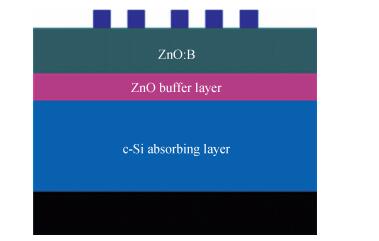
 DownLoad:
DownLoad:
